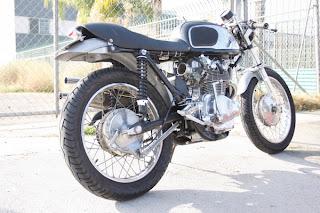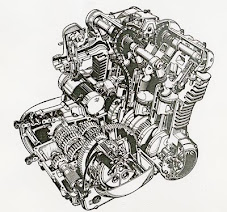The latest job to be finished was the forks. The chrome tubes were pitted with rust when I got the bike, and the rubber in the seals was old and hard, both consequences of the coastal location of it's slumber. A re-seal was definitely in the cards.
The old forks came apart pretty quick. Despite their pitted tubes and cracked dust seals, they actually held some air pressure from 27 years ago. Amazing. The oil was nasty with condensation and metal particles though.
I tried polishing the rusty fork tubes with 800 grit wet sandpaper, fine steel wool and chrome polish, but the left tube was too far gone. The right tube would work in a pinch - it had only one tiny pit that I filled with a drop of epoxy and sanded flat. I debated using epoxy to fill the numerous pits on the right tube, but I rejected the idea as too half-assed for me. I really like to do things the right way. So, despite the hit it would make to my budget, I sourced a replacement used tube on eBay. I ended up buying an entire fork set that had one good tube.
The eBay forks come with an aftermarket fork brace (1980s Pro Circuit - I thought they only made dirt stuff?) which should do even more for the front end. The forks also had an air tube crossover kit, which needs a new fitting to work.
While the forks were off I disassembled the steerer tube and steering bearings. The tapered bearings on this bike are definitely over built, and 12,000 miles is nothing for them. New Bel-ray waterproof grease went back in, and I carefully adjusted them to eliminate any slop or unnecessary friction.
After thoroughly cleaning all the internal parts, I assembled the suspension on the bike and added fork oil to the stock level - 140mm from the top. I pumped it a few times and all was good. I then installed the front wheel and brake calipers and bled the brakes. A nice, hard lever was the result.
All that's left is cosmetics, and of course starting the engine for the first time in 27 years. I can't wait to get it back on the road!








